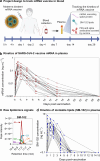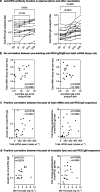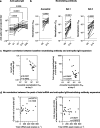Blood Distribution of SARS-CoV-2 Lipid Nanoparticle mRNA Vaccine in Humans
- PMID: 39298422
- PMCID: PMC11447892
- DOI: 10.1021/acsnano.4c11652
Blood Distribution of SARS-CoV-2 Lipid Nanoparticle mRNA Vaccine in Humans
Abstract
Lipid nanoparticle mRNA vaccines are an exciting but emerging technology used in humans. There is limited understanding of the factors that influence their biodistribution and immunogenicity. Antibodies to poly(ethylene glycol) (PEG), which is on the surface of the lipid nanoparticle, are detectable in humans and boosted by human mRNA vaccination. We hypothesized that PEG-specific antibodies could increase the clearance of mRNA vaccines. To test this, we developed methods to quantify both the vaccine mRNA and ionizable lipid in frequent serial blood samples from 19 subjects receiving Moderna SPIKEVAX mRNA booster immunization. Both the vaccine mRNA and ionizable lipid peaked in blood 1-2 days post vaccination (median peak level 0.19 and 3.22 ng mL-1, respectively). The vaccine mRNA was detectable and quantifiable up to 14-15 days postvaccination in 37% of subjects. We measured the proportion of vaccine mRNA that was relatively intact in blood over time and found that the decay kinetics of the intact mRNA and ionizable lipid were identical, suggesting the intact lipid nanoparticle recirculates in blood. However, the decay rates of mRNA and ionizable lipids did not correlate with baseline levels of PEG-specific antibodies. Interestingly, the magnitude of mRNA and ionizable lipid detected in blood did correlate with the boost in the level of PEG antibodies. Furthermore, the ability of a subject's monocytes to phagocytose lipid nanoparticles was inversely related to the rise in PEG antibodies. This suggests that the circulation of mRNA lipid nanoparticles into the blood and their clearance by phagocytes influence the PEG immunogenicity of the mRNA vaccines. Overall, this work defines the pharmacokinetics of lipid nanoparticle mRNA vaccine components in human blood after intramuscular injection and the factors that influence these processes. These insights should be valuable in improving the future safety and efficacy of lipid nanoparticle mRNA vaccines and therapeutics.
Keywords: COVID-19; PEGylated lipid nanoparticle; biomolecular coronas; immunoglobulins; kinetics of mRNA; particle–immune cell interactions.
Conflict of interest statement
The authors declare no competing financial interest.
Figures






References
Publication types
MeSH terms
Substances
LinkOut - more resources
Full Text Sources
Medical
Miscellaneous

